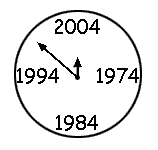What's So Cool about Saturn?
------------------------------------------------------------------------
Haven't we visited Saturn before? Not just once, but a few times?
Yes, but that was almost 20 years ago. And Pioneer 11 and the two Voyager spacecraft didn't hang around to really check out Saturn in depth. They just whizzed by and on their way!

When Cassini arrives, it will get into orbit and study Saturn for at least four years!!

But why study Saturn at all?
What's so cool about Saturn?

How about rings, Rings, RINGS!! Saturn has the widest, strangest, and most numerous rings of any planet in our solar system. Voyager saw braids and spokes in the rings, which was a BIG surprise. We want to know more! What are they made of? How come the ring material keeps that shape and doesn't float away? Maybe Cassini will help us understand.

We also want to learn more about the big magnetic bubble of particles around Saturn, called its "magnetosphere." How is it generated, and how does it affect Saturn and its many different moons? Cassini will actually "touch" the particles in the magnetosphere with its instruments, so we'll get more than just a close look at this strange magnetic field!

Saturn has 18 known moons, too -- many we haven't seen real close. Many we don't understand at all! Like Iapetus. This moon has one dark side and one bright side, like a yin-yang symbol. Which color is the real surface of the moon, and where does the opposite color come from? Does it percolate from inside the moon or rain down from space? The astronomer Cassini first noticed this problem, perhaps Spacecraft Cassini will help us find the answer.
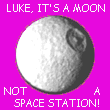
Mimas has a huge crater called Herschel, evidence of an impact that almost shattered this moon. Some people have wondered if Mimas inspired the look of the Death Star in the movie Star Wars. But that movie came out in 1976, three whole years before Voyager took the first close-up picture of Mimas!!

The small moons Pandora and Prometheus stay close to one of Saturn's rings and are called "shepherd moons." Scientists believe that shepherd moons might contribute to the ring materials, and probably keep them in their ring shape, like a shepherd keeps sheep together.

Enceladus is a moon with an icy bright surface which also might provide material for Saturn's rings. The theory is that ice geysers blow material into space, which then gets captured in the rings. If we're lucky, Cassini may spot one erupting!
Dione and Tethys are unusual in that they have little companion moons called "Trojan moons" that orbit along with them . . .
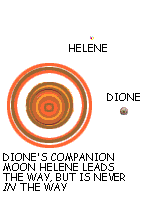
Helene orbits in front of Dione, and Calypso and Telesto escort Tethys on either side as they all orbit Saturn. These small companions don't get real close to their large moon companion - they keep their distance about 60 degrees ahead or behind, and just keep pace.
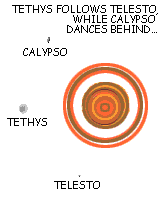
Tethys has interesting surface features, too, like an even bigger crater than Mimas - in fact, the crater is BIGGER than Mimas itself! Tethys also has a huge trench called Ithaca Chasma that Cassini will explore with cameras. This long canyon stretches 3/4 of the way around Tethys' surface! What a tourist attraction that could be someday!
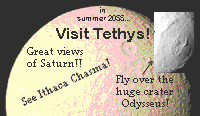
Janus and Epimetheus show another strange way of orbiting. They "co-orbit" or share an orbit like the Trojan moons do, but in a different way: they switch orbits when they get close to one another! The moon closer to Saturn will actually force the farther moon to take its orbit, until that moon comes all the way around and pulls the first moon back into the closer orbit.
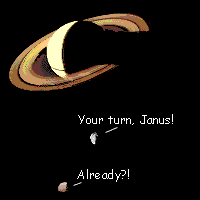
Phoebe, the farthest known moon, orbits in the opposite direction than the other moons and may even be a captured asteroid or an extinct comet. Cassini will pass it on the way in and get a close look at its red surface.
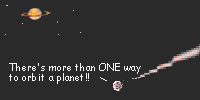
And Hyperion, Rhea, Atlas, and Pan are all so interesting and need to be studied, too.

Cassini may even find more moons! But not all of the icy satellites we do know about can be closely explored on this trip, since they are very spread out around Saturn.
However, Cassini will visit mysterious Titan on almost every orbit, and the Huygens probe will even try and land there! Titan is Saturn's largest moon and the only one with an atmosphere. What's under those thick orange clouds? We'll find out when the Huygens probe flies in and takes pictures.
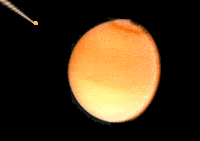
Titan may have lakes or oceans of methane or ethane. Huygens will fly down and see if the surface is liquid or land, and will get all sorts of information about Titan. There's even a small microphone on the probe, to send back sounds from Titan. We might hear wind, or the probe scraping the surface while landing, or maybe a big splash!
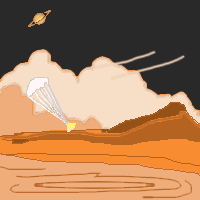
Wait! We forgot to mention Saturn itself!!

The planet *INSIDE* the rings is fascinating, too. Like Jupiter, it's a big ball of cold gas with no solid surface and a hot core. We already know it is made of material less dense than water. That means if you had an ocean big enough to toss it in, Saturn would float!
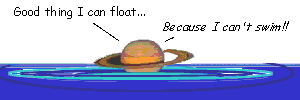
While we know some things about Saturn, there's a lot we don't know


